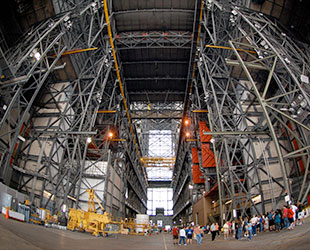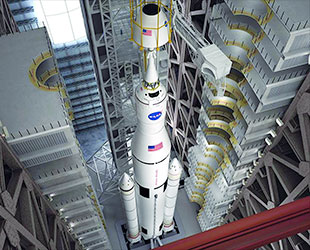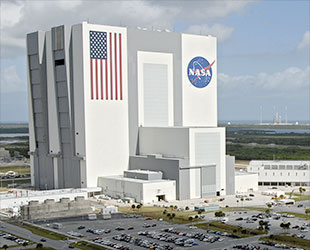January 21, 2014 — A hugely popular, hugely historic and just plain huge NASA tour spot is closing to the public as the space agency picks up the pace preparing the facility for the future of U.S. space exploration.
Tours taking the public into the 52-story Vehicle Assembly Building (VAB) at the Kennedy Space Center in Florida are set to end on Feb. 11, the Kennedy Space Center Visitor Complex announced recently.
Update for Jan. 23: NASA has extended availability to the VAB until Feb. 23. Public tours will continue until then.
Public access to the voluminous facility is being halted as work resumes to renovate the VAB for the Space Launch System (SLS), NASA's next-generation heavy-lift rocket. The towering launch vehicle will provide NASA with a new capability for human exploration beyond Earth orbit.
"[We have] been honored to give our guests rare access to the VAB for the past two years, yet we knew that the day would come when preparations for the SLS would take precedent," Therrin Protze, the chief operating officer for the NASA visitor complex, said in a statement. "Kennedy Space Center is an operating space program facility, and preparations for the next chapter in space exploration are the utmost priority."
"We are very excited about the future," Protze said.

Wide-angle view down the transfer aisle in the Vehicle Assembly Building at NASA's Kennedy Space Center. (collectSPACE) |
The current public tours of the Vehicle Assembly Building began in November 2011 after the facility was off-limits for three decades while the space shuttle was flying. The lull in activity between the end of the shuttle program and now allowed for the visitor complex to bring its guests inside the VAB for the first time since 1978.
The 525-foot-tall (160 meter) building — the largest single-story structure and the fourth largest building by volume in the world — was used for 30 years to stack space shuttle orbiters with their boosters and external fuel tanks for 135 missions. Before then, the building's original purpose was to assemble the stages that formed the 363-foot (110 m) Saturn V rockets that launched astronauts to the moon.
The building, its side adorned with a painted U.S. flag so large that a city bus could fit within any one of its red and white stripes, has attracted tourists since it was first built in 1966. During the shuttle program however, spectators have had to settle for an outside view only as the fuel in the vehicle's twin solid rocket boosters made the building too dangerous to allow large groups of visitors inside.
Similar boosters will be employed by the Space Launch System, but it is the work pending to the VAB itself, rather than the rocket's fuel, that is now requiring that the public to be kept out again.

Artist's rendering of NASA's Space Launch System (SLS) rocket being stacked inside the Vehicle Assembly Building. (NASA) |
Renovations to the VAB over the past several years have included removing shuttle-era work platforms from one of the building's four high bays to accommodate the SLS and extracting more than 150 miles (240 km) of now obsolete Apollo- and shuttle-era cabling.
As the public tours come to an end, construction will begin on new SLS-tailored access platforms and the installation of state-of-the-art command, communication, control and power systems that will be needed to perform testing and verification prior to the SLS and other rockets being rolled out to the launch pad.
NASA is planning its first test flight of the Space Launch System in late 2017. Topped by an unmanned Orion crew capsule and European-built service module, the more than three week Exploration Mission 1 (EM-1) will travel 43,000 miles (70,000 km) beyond the moon before returning to the Earth.
The EM-1 flight is intended as a precursor to NASA's first crewed SLS mission in 2021, which the space agency has proposed having rendezvous with an asteroid redirected in the vicinity of the moon.
NASA's first test of the Orion capsule, called Exploration Flight Test-1 (EFT-1), is scheduled to lift off in September of this year atop a United Launch Alliance Delta IV Heavy rocket. Though the VAB won't be needed to assemble that booster, the building is being used to practice stacking the Orion components.

The Vehicle Assembly Building is the largest one-story structure and fourth largest building by volume in the world. (NASA) |
In addition to its "Up-Close" public tour dedicated to the VAB, the Kennedy Space Center Visitor Complex is also curtailing its "Mega Tour," which also included the Vehicle Assembly Building. Premium tours to the Launch Control Center (LCC) adjacent to the VAB and the launch pads are continuing, although both are also subject to cancellation if work for the SLS or other programs requires.
For more information on the "Up Close" tours, see NASA's Kennedy Space Center Visitor Complex website.
